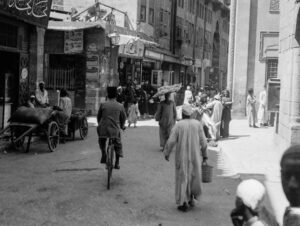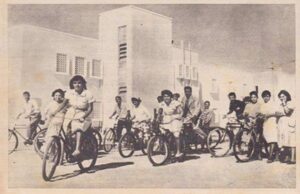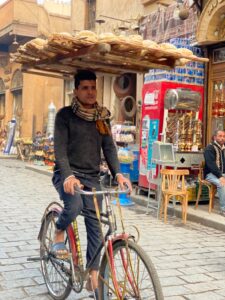Today, greater Cairo— Al Qahira: the victorious or the city of thousand minarets—is a mosaic of urban centers. Its citizens increasingly commute by car especially for long distances. That has not always been the case. To understand how its transport practices developed, we need to go back in time.

Cycling in Cairo became popular early in the twentieth century when high placed British colonial administrators, local elites, and high-heeled tourists used expensive bicycles for their leisure to tour around the city and visit the Pyramids. Then between 1900 and 1960s, cycling changed from leisure for the happy few to a utility activity for professionals and workers like the police, military, missionaries, doctors, bakers, and working-class men and women, who commuted daily by bicycle. Cycling, along with walking, was still viewed favorably.

As Cairo expanded, so did its transport options. To get around the city, people used the newly built trams along with cycling and walking, while peddlers transported good by non-motorized wheelers like horse carts and cargo bikes. This period was marked by a diverse range of transport choices like walking, cycling, public transit, and modest automobility
In the 1970s, Cairo underwent a significant transformation with the introduction of a car-oriented masterplan, leading to the demolition of half of the city’s extensive tramways (120 km). The urban expansion combined with the divestment in public transit facilitated the rise of new middle-class and elite groups, who relied on automobility. Today, the modal split in Cairo has shifted significantly, with only a few residents commuting by bicycle. The dominant modes now include public transit and privately owned cars.

Sadat’s 1970s masterplan, however, changed the urban landscape fundamentally, expanding the city to the Greater Cairo Region (GCR) sprawling into the desert and creating new satellite cities that—without investments in public transit—resulted in longer distances and the increased middle-class automobility. It affected working-class people in particular. Still, many Cairo residents engage in intra-neighborhood mobility with walking as a viable option, while essential services like supermarket delivery and fresh bread transport is done by bicycle. Leisure cycling has also found a niche, with regular cycling events occurring in specific neighborhoods.
This raises the question: Is Cairo a Cycling City—or become one again? It depends on our perception and definition of a cycling city: a city where its citizens depend on bicycles as a main mode of transit? To get around and across the greater urban region by bicycle may not suit metropoles like Cairo, but walking and cycling may be convenient for internal mobility within the neighborhood or as an integrated mode of transport among other modes like public transit.
In the Cairo chapter of the Cycling Cities: The African Experience, Nourhan Abelghaffar, Carine Khalil, and Ranya Ayman Lotfy analyze and investigate these aspects to understand the potentials and challenges of people’s daily use of bicycles and the chances of Cairo becoming a true cycling city, again.